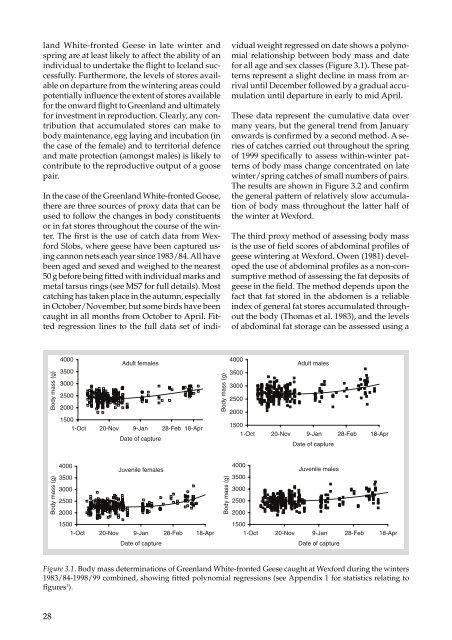The Greenland White-fronted Goose Anser albifrons flavirostris
The Greenland White-fronted Goose Anser albifrons flavirostris
The Greenland White-fronted Goose Anser albifrons flavirostris
Create successful ePaper yourself
Turn your PDF publications into a flip-book with our unique Google optimized e-Paper software.
land <strong>White</strong>-<strong>fronted</strong> Geese in late winter and<br />
spring are at least likely to affect the ability of an<br />
individual to undertake the flight to Iceland successfully.<br />
Furthermore, the levels of stores available<br />
on departure from the wintering areas could<br />
potentially influence the extent of stores available<br />
for the onward flight to <strong>Greenland</strong> and ultimately<br />
for investment in reproduction. Clearly, any contribution<br />
that accumulated stores can make to<br />
body maintenance, egg laying and incubation (in<br />
the case of the female) and to territorial defence<br />
and mate protection (amongst males) is likely to<br />
contribute to the reproductive output of a goose<br />
pair.<br />
In the case of the <strong>Greenland</strong> <strong>White</strong>-<strong>fronted</strong> <strong>Goose</strong>,<br />
there are three sources of proxy data that can be<br />
used to follow the changes in body constituents<br />
or in fat stores throughout the course of the winter.<br />
<strong>The</strong> first is the use of catch data from Wexford<br />
Slobs, where geese have been captured using<br />
cannon nets each year since 1983/84. All have<br />
been aged and sexed and weighed to the nearest<br />
50 g before being fitted with individual marks and<br />
metal tarsus rings (see MS7 for full details). Most<br />
catching has taken place in the autumn, especially<br />
in October/November, but some birds have been<br />
caught in all months from October to April. Fitted<br />
regression lines to the full data set of indi-<br />
Body mass (g)<br />
Body mass (g)<br />
28<br />
4000<br />
3500<br />
3000<br />
2500<br />
2000<br />
Adult females<br />
1500<br />
1-Oct 20-Nov 9-Jan<br />
Date of capture<br />
28-Feb 18-Apr<br />
4000<br />
3500<br />
3000<br />
2500<br />
2000<br />
Juvenile females<br />
1500<br />
1-Oct 20-Nov 9-Jan<br />
Date of capture<br />
28-Feb 18-Apr<br />
Body mass (g)<br />
Body mass (g)<br />
vidual weight regressed on date shows a polynomial<br />
relationship between body mass and date<br />
for all age and sex classes (Figure 3.1). <strong>The</strong>se patterns<br />
represent a slight decline in mass from arrival<br />
until December followed by a gradual accumulation<br />
until departure in early to mid April.<br />
<strong>The</strong>se data represent the cumulative data over<br />
many years, but the general trend from January<br />
onwards is confirmed by a second method. A series<br />
of catches carried out throughout the spring<br />
of 1999 specifically to assess within-winter patterns<br />
of body mass change concentrated on late<br />
winter/spring catches of small numbers of pairs.<br />
<strong>The</strong> results are shown in Figure 3.2 and confirm<br />
the general pattern of relatively slow accumulation<br />
of body mass throughout the latter half of<br />
the winter at Wexford.<br />
<strong>The</strong> third proxy method of assessing body mass<br />
is the use of field scores of abdominal profiles of<br />
geese wintering at Wexford. Owen (1981) developed<br />
the use of abdominal profiles as a non-consumptive<br />
method of assessing the fat deposits of<br />
geese in the field. <strong>The</strong> method depends upon the<br />
fact that fat stored in the abdomen is a reliable<br />
index of general fat stores accumulated throughout<br />
the body (Thomas et al. 1983), and the levels<br />
of abdominal fat storage can be assessed using a<br />
4000<br />
3500<br />
3000<br />
2500<br />
2000<br />
Adult males<br />
1500<br />
1-Oct 20-Nov 9-Jan<br />
Date of capture<br />
28-Feb 18-Apr<br />
4000<br />
3500<br />
3000<br />
2500<br />
2000<br />
Juvenile males<br />
1500<br />
1-Oct 20-Nov 9-Jan<br />
Date of capture<br />
28-Feb 18-Apr<br />
Figure 3.1. Body mass determinations of <strong>Greenland</strong> <strong>White</strong>-<strong>fronted</strong> Geese caught at Wexford during the winters<br />
1983/84-1998/99 combined, showing fitted polynomial regressions (see Appendix 1 for statistics relating to<br />
figures 1 ).


